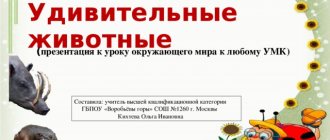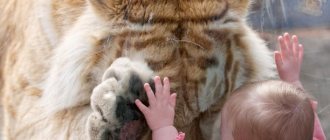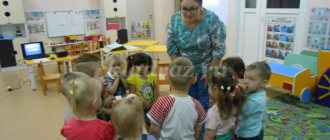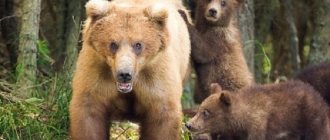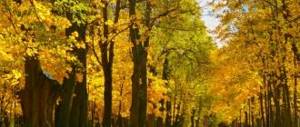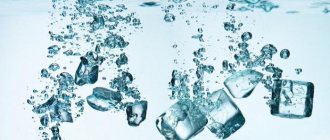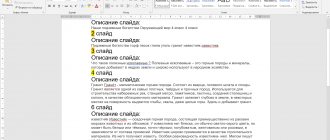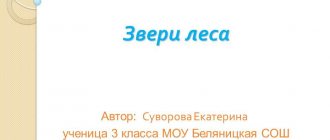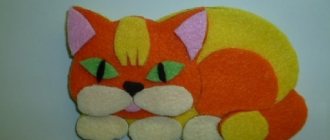Presentation “Wild animals of our forests”
Syabruk Marina Konstantinovna, speech therapist teacher
- Abstract of GCD in the senior group on the topic: “Wild animals of our forests”
- Speech therapist’s homework on the topic “Wild animals of our forests”
- Summary of a lesson on the formation of lexical and grammatical categories in children with special needs in the senior speech therapy group “Case Constructions”
- Summary of a speech therapy lesson in the senior ONR group on the formation of lexical and grammatical categories of language and the development of coherent speech
- Lesson plan for the formation of lexical and grammatical means of the language. Theme “Animals of hot countries”
( 1 liked, average score: 5.00 out of 5)
Loading...
Wild animals. The world around us - 1st grade, a sample of work was completed by Kolodina N.V. - presentation
1 The theme of the project “Wild Animals” The world around us - 1st grade, a sample of work was completed by Kolodina N.V.
2 Hypothesis Why is it necessary to protect wild animals? To keep our Earth alive, blooming and healthy, we must take a responsible and caring approach to the nature of our native land, our locality: love and take care of nature! In order not to end up one day on our huge planet completely alone.
3 We have developed a plan: Getting to know wild animals The animal world is in danger The importance of creating a red book Protecting the animal world Rules of behavior in nature
4 “Wild Animals” Stop -1
5 Amur tiger A close relative of our domestic cat. Its length is more than 3 meters. Strong, dexterous, beautiful beast. Lives in the taiga.
6 Bear: A large and very strong animal that lives in forests. The length of a brown bear is 2.5 m, body weight reaches kg. He walks in the forest carefully, almost silently. The bear is an omnivore. Eats juicy herbs, berries, mushrooms, nuts, acorns, and loves honey. But it also feeds on live food. Attacks domestic animals, moose, wild boars
7 Wolf Wolves do not hunt alone, but together. They usually roam in small flocks of individuals. During the day they hide in bushes and along ravines. They hunt moose, cows, partridges, chase hares, and do not disdain carrion. Very hungry wolves dare to attack dogs, and in the forest, bears sleeping in a den.
8 Fox is a predatory animal. IN BODY STRUCTURE, A FOX IS SIMILAR TO A WOLF AND A DOG. THE MUZZLE IS LONG, POINTED, AND THE UPPER LIP IS RAISED. EYES WITH A VERTICAL PUPIL SEE GOOD IN THE DARK. EARS ERECT, ALWAYS ALWAYS. A FOX CAN RUN LONG AND FAST. THE MAIN PREY OF FOXES ARE SMALL RODENTS. IN SUMMER THEY EAT INSECTS, BERRIES AND FRUITS OF PLANTS.
9 Squirrel Forest animal. Body length cm, weight -1 kg. A characteristic feature is tassels at the ends of the ears and a fluffy tail. When a squirrel jumps from tree to tree or jumps to the ground, its tail serves as a rudder and parachute. They feed on cone seeds, pine nuts, acorns, eat various berries, mushrooms, buds, fruits, and catch beetles and butterflies.
10 Roe deer Roe deer is an elegant, slender, and graceful animal. She has a pretty face and such beautiful huge eyes. The body structure of the roe deer is similar to the wapiti, but much smaller. With its entire build, the roe deer is adapted for running by jumping rather than walking.
11 Stop -2 “The animal world is in danger” Great wounds that humans inflict on nature: 1. Deforestation 2. Air pollution 3. Water pollution 4. Fire 5. Poaching
12 Stop-3 The meaning of the creation of the “Red Book” - This book is called so because the red color is a danger signal, a call to the mind and conscience of everyone: we will not repeat the fatal mistakes made in the name of profit, blind hunting passion. — The book itself does not protect, but warns, records lists of animals that are on the verge of extinction. Therefore, the purpose of creating the Red Book is to preserve the animal world.
13 Pages of the “Red Book” On the black pages are lists of those animals that we will not see. All that was left of them were stuffed animals, skeletons, or nothing at all.
14 Pages of the “Red Book” Rare and endangered animals are recorded on the red pages. There are very few of them left.
15 Pages of the “Red Book” On the yellow pages are those animals whose numbers are rapidly declining, which are in danger of being “relocated” to the dangerous red pages.
16 Pages of the “Red Book” On the white pages are those animals whose numbers have always been small.
17 Pages of the “Red Book” The gray pages contain those animals that are still little studied, their habitats are difficult to access.
18 Pages of the “Red Book” The green pages contain the most hopeful animals that have been saved from extinction.
19 Stop -3 “Protection of wildlife” 1) Purification of water and air. 2) Planting new forests. 3)Creation of nurseries. 4) The destruction of all species listed in the Red Book of Russia is prohibited. 5) Protection of nature reserves and national parks.
20 Stop -4 “Rules of behavior in nature” - If you come to the forest for a walk, breathe fresh air, run, jump and play, just don’t forget that you can’t make noise in the forest, even sing very loudly. The little animals will get scared and run away from the forest edge. Don’t break oak branches, never forget to remove debris from the grass, there’s no need to pick flowers in vain! Don't shoot with a slingshot: you didn't come to kill! Let the butterflies fly, well, who are they bothering? - Here you don’t need to catch everyone, stomp, slam, beat with a stick. You are just a guest in the forest, here the owner is the oak and the elk. Take care of their peace, because they are not our enemies! Help the forest animals, prepare feeders for them. - And then any animal - be it a weasel or a ferret, a forest hedgehog, a river fish - will say: “You are my friend!” Thank you!"
21 Conclusion: Take care of this Earth, this water. Loving even a small epic, Take care of all the animals inside nature, Kill only the animals inside yourself!
Presentation “Domestic and wild animals”
- May 5, 2012
Competition "Presentation Master - 2012"
Nomination "Presentation in the pedagogical process in preschool educational institutions"
Game exercises are designed for children of senior preschool age. The tasks are varied, playful, and entertaining.
Goal: activation of speech activity, development of lexical and grammatical means of the language.
Tasks:
- consolidate children's knowledge about wild and domestic animals;
- expand the active vocabulary on the topic “Domestic and wild animals”;
- consolidate generalizing concepts;
- expand the verb dictionary and the dictionary of signs;
- Exercise children in the use of possessive adjectives.
Practical significance.
The proposed games in the presentation make it possible to increase the motivation of children to obtain and assimilate new knowledge, develop perception, attention, and thinking by increasing the level of visibility, improving the quality of learning and the performance of children.
The use of games will effectively correct speech deficiencies and will enhance the cognitive activity of children.
The proposed games can be used as an independent manual, or as a separate part, in the process of direct educational activities with children.
Description of games.
"Who lives where?" (slide number 2). Instructions: children are invited to look at the animals, name them, place them: who lives where.
“Guess who it belongs to?” (slide number 3). Instructions: children are asked to look at the animals, note what is missing from each animal, look at individual details, determine who owns what, name whose part it is (squirrel tail, etc.).
“Gather the family” (slide No. 4, 5). Instructions: children are asked to look at the animals, name the parents and their baby, clearly pronouncing the endings.
"Whose house?" (slide number 6). Instructions: children are invited to look at pictures depicting dwellings and animals; find and name, clearly pronouncing the endings, a home for each animal.
“Who eats what?” (slide number 7). Instructions: children are invited to look at animals, pictures of animal food; identify and name who eats what.
"Who's doing what?" (slide number 8). Instructions: children are asked to look at the animals, name their actions, pronouncing the words and endings.
“What benefits do pets bring to humans?” (slide number 9). Instructions: children are asked to look at animals and pictures depicting objects, connect with an arrow the animal and the picture, with the benefit it brings to humans.
“Find the odd one out” (slide no. 10, 11). Instructions: children are asked to look at the animals, find the odd one out, and explain why.
Application: Presentation.
Author: Elena Yuryevna Kopaneva, senior teacher of the highest category, State Budgetary Educational Institution Secondary School No. 15, structural unit of the Cheburashka Kindergarten, city. Novokuibyshevsk, Samara region. Teaching experience 19 years. Diploma winner of the “Teacher of the Year” competition, 2008. I take an active part in methodological associations.
presentation “Wild animals in autumn” presentation for a lesson on speech development (middle group)
Slide 1
ANIMALS IN AUTUMN Completed by: teacher of MKDOU kindergarten “Topolek” of combined species Zvereva Valentina Leonidovna
Slide 2
GROUPS OF ANIMALS BIRDS INSECTS REPTILES AND AMPHIBIDES
Slide 3
Animals ? ? ?
Slide 4
I'm changing my fur coat to a gray one. I collect mushrooms, berries, cones, hang them on branches and store them in hollows. squirrel
Slide 5
He has funny cheeks and five stripes on his back. And behind the cheeks there are bags to carry seeds. chipmunk
Slide 6
This animal stores hay in the summer for the winter. Collects herbaceous plants and dries them in the sun and puts them in a stack in a special place. Food supplies usually last for four months. pika
Slide 7
I know how to build dams on rivers and streams, lay canals in the forest and cut down thick trees, build huts for housing. I diligently cut up a fallen tree, stocking up branches and a trunk for the winter. beaver
Slide 8
What do these animals have in common? They are stocking up for the winter.
Slide 9
We shed in the fall. We need to take care of a reliable shelter where we can sleep until spring, but for this we need to accumulate a reserve of fat. Fat is a food supply for the entire winter. bear
Slide 10
I'm a very careful animal. I hunt at night. The body is covered with silver-gray stiff bristles. White stripes extend from the nose. In the fall I gain fat - I prepare for winter. I eat rodents, frogs, lizards, and dig up worms. When it gets cold I go to bed. badger
Slide 11
snake frog
Slide 12
They go into hibernation. What unites these animals?
Slide 13
And I have... As many as thirty-three pantries, In each there are seeds for my little ones. Eat, children, eat to your heart's content - There are many seeds in the field. mouse
Slide 14
We are changing our fur coat to a warmer and fluffier one. We find our main prey – voles – without any tricks. The nose and ears help. But it’s difficult for us to catch up with a hare, unless we accidentally run into a scythe or come across a little hare. fox
Slide 15
He has branched horns and fast hooves. Shaking his head, he touches the sky... elk
Slide 16
The fog falls, Wakes up... Digging the ground near the river, Sharpening sharp fangs. boar
Slide 17
He wears shiny fur and drinks water carefully. His house is in a cedar thicket, He leads a secretive life. sable
Slide 18
Day and night he prowls the forest, Day and night he searches for prey. He walks and wanders in silence, his gray ears stick up. wolf
Slide 19
Animals escape from enemies in different ways: some in hollows, some hiding under the snow, some in holes. And I don’t know how to do any of this. I have a lot of enemies. And yet, I live, I don’t grieve. My nose, sensitive ears, fast legs and inconspicuous fur coat help me out. hare
Slide 20
What do these animals have in common? They can feed themselves
Slide 21
September is also called the month of tits. In September, the tit asks autumn to visit. September is cold, father, but there is plenty to feed. “September hurries the birds on their way,” says the proverb. No matter how good the autumn weather is, no matter how satisfying the September forest is, you still have to fly away - the journey ahead is long.
Slide 22
Animals in autumn? ? ? ? Make supplies Go into hibernation Can feed themselves
Slide 23
BIRDS COLD IN AUTUMN INSECTS WILD GRASSES RESERVOIR FREEZES
Slide 24
DEPARTURE OF BIRDS Noisy caravan of geese Stretched to the south...
Slide 25
Birds fly south, where it is warm.
Slide 26
So winter will come soon.
Slide captions:
Prepared by teacher: Kulakova O.A. Presentation on the topic: “Wild animals”
There was a pillow with needles lying between the trees. She lay there quietly, then suddenly ran away.
A red-haired fiery lump, With a tail like a parachute, Jumping quickly through the trees, He was there... Now he’s here. He's as fast as an arrow. So this is...
The red-haired cheat hid under the tree. The cunning one is waiting for the hare. What is her name?..
Clubfoot and big, He sleeps in a den in winter. He loves pine cones, he loves honey, Well, who can name it?
All the time he prowls through the forest, He is looking for someone in the bushes. He snaps his teeth from the bushes, Who will say this?
He has a huge mouth, he is called...
Two humps, hooves, a tail... He is huge! There is a crowd of people in front of him. Children, who is he?
We know him to be big and kind, and we respect him for that. The ears are very big, the paws are so strong. He has a long trunk, We love him most of all. You know exactly who he is, Children, that’s for sure...
Very formidable and brave, He waves his shaggy mane: And growls, as if in a chant - He is brave, strong...
He is a spotted giant - His neck is long, like a crane: A “count” walks around the safari, And his name is...
